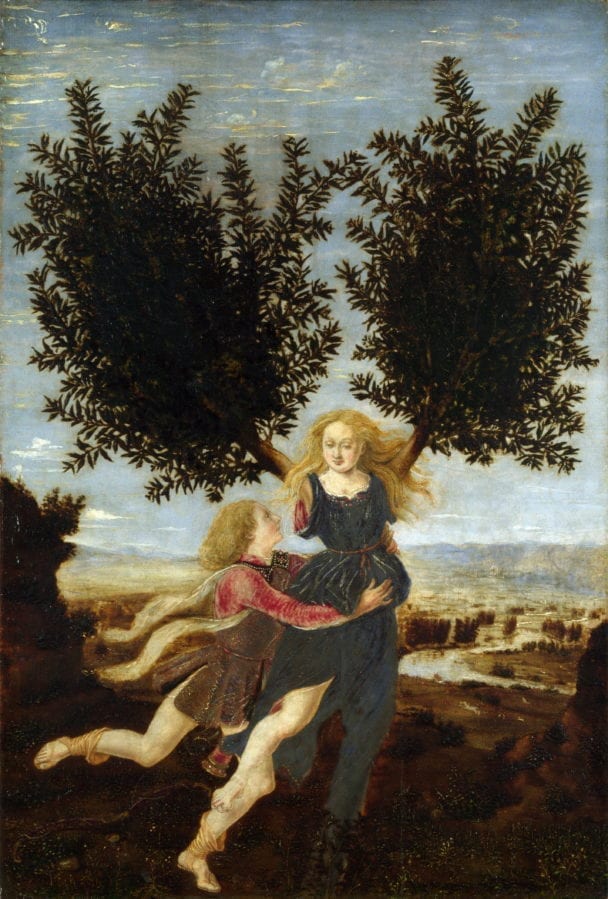What twists await in the Apollo and Daphne painting?
- The God Apollo’s Me Too moment.
- Daphne prefers life as a tree over Apollo’s advances.
- In Apollo and Daphne – her choice is everything.
Antonio Pollaiuolo’s 15th century Italian masterpiece Apollo and Daphne explores this myth. It’s the classic tale of unrequited love, with a laurel-scented twist. Apollo was far too fond of dismissive Daphne. We can see him clinging to her here. It’s also clear that she’s changing under the weight of his embrace.
Listen to the podcast version of this post with a click below.
That’s because she asked her father, the river god, to turn her into a tree. This is her only escape from Apollo’s literal clutches. If you look just beyond Daphne to the right, you can see her father snaking his way to her. She will soon rest beside him, a lifelong contented spinster next to dear old Dad.
Apollo was twin brother to Artemis, goddess of the hunt. But he plays the predatory role here. Apollo fails at it, though. Daphne slips into the botanical life rather than succumb to his pursuit. Soon he will stand by this river clutching a tree trunk in sorrow. It’s not the outcome one might expect for a sun god. Apollo also symbolizes truth and healing, though. He’ll be OK. This was a youthful phase for him. It’s his wake up call. We all need them sometimes, even sun gods. For some it’s a buddy handing us a copy of He’s Just Not That Into You. Others find themselves embracing the bark of an unyielding laurel.
Daphne’s Moral Choice
Masterpieces often grapple with humanity’s toughest moral quandaries. Apollo and Daphne joins that cadre. Daphne wishes to remain true to herself. She listens to her heart. The God Apollo pursues her regardless. He’s blind to her anxiety. So ignorant, in fact, that he doesn’t notice Daphne’s turning into a laurel tree. Of course, he will see it at some point. The sun he rules will shine upon this scene and show him the error of his clinging ways.
Daphne’s choice to become a tree shines a light upon the morality of staying true to oneself. It’s an Apollo-brand lesson. After all, he’s the god of sunshine and truth. Daphne provides the morality and choice. From this scene forth she’ll stand tall and true as a laurel tree. Apollo also carries this moral lesson with him onward from here. He wears a wreath of laurel from that day forward – forever.
Together Apollo and Daphne teem with morality lessons. Apollo teaches us to let go. Daphne, though, reveals the risks of stubborness. You might end up stuck in your father’s basement forever. The only way Daphne can make a move from this day forth is if a wind rushes through her branches. Apollo may be heartbroken. But he’s also unbound.
In a way this proves how Daphne mattered. Her choice made an impact that lasted. Many past loves, like the unrequited tale of Apollo and Daphne, teach profound lessons. In another masterpiece, Venus Lamenting the Death of Adonis, a deep love lesson reverberates as well. The wisest among us step out of the shadows to shine the light of truth and learn from them. That’s what this painting conveys in its own lovely way.
Antonio Pollaiuolo – Factoids
- Italian painter, Antonio Pollaiuoulo was born in January of 1431 (or 2) in Florence, Italy.
- His elder brother, Piero was also a renowned artist.
- The duo employed many arts including goldsmithing, sculpture, metalwork, engraving, and painting.
- His work Battle of Ten Nudes has been called the most significant engraving in European history.
- Although Antonio was ten years younger, he’s considered the better artist in comparison to Piero.
- He trained as a sculptor in the famous Ghiberti workshop.
- Antonio went on to establish his own studio in 1459.
ENJOYED THIS Apollo and Daphne ANALYSIS?
Check out these other essays on Italian painters.
